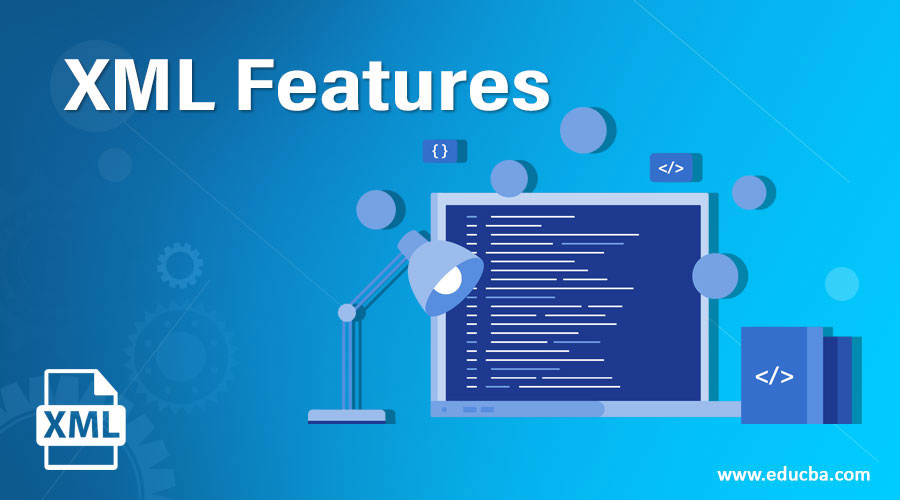Updated March 27, 2023

Introduction to XML Features
XML is a self-descriptive markup language designed as per W3C (World Wide Web Consortium) recommendations. It was designed to store and transport data via various web services connecting different applications and promoting data exchange. XML is a simple and powerful tool in this era of data flow between multiple applications. It was developed as a subsequent and simplified version of its predecessor SGML which was developed long back in 1986 for general communication. While SGML uses DTD (document type definition) to function, XML does not require DTD necessarily along with this provides flexibility to deliver well-formed data over the web. It is a powerful data transfer universal package wrapped under the cover of simplicity. The main XML Features are described below.
Top 13 Important Features
Following are some important features marking XML language.
1. Separation of Moving Data from HTML
Unlike changing the static HTML page every time when we want to change data on the page, XML provides a lot of flexibility by focusing just on data. The look and feel the character of any website will be taken care of by HTML along with CSS and javascript. XML will solely manage how data is exchanged by designing data-centric properties in a separate XML file which then can be rendered whenever required.
2. Self-Validations using XML
A newly created XML document can be validated using XML schema or DTD. This is used to ensure that the XML document created is syntactically right and reduces the chances of issues that could have been raised due to err XML documents.
3. Roots Bases Structure
XML uses a tree-based structure containing data roots. This impacts data retrieval positively. Tree structure improves the data navigation speed by double in comparison to traditional methods of data storing. The parent root contains child roots. Any data structure and hierarchies can be easily defined in most relevant terminology to facilitate speedy data transfer with the help of root nodes and attributes attached to these nodes.
4. Platform Independent
XML is developed independently of any application platform. XML data is stored in plain text format. It provides an independent way of data transfer encouraging developers to use widely. Also, there are some international standards maintained for the data transfer using XML. This fact encourages developers to develop platform-independent applications that are accessible from anywhere around the globe.
5. XML Promotes Data Transport
Since it can be used by the different application which is not compatible. Incompatible applications can do communication with the help of XML pages. It uses serialization to make sure that it transmits data without any modifications.
6. Simplified Structure
XML is very simple with hardly around 10 syntax rules. We need to create our own tags with the relevant names. The XML code can be written over text files and can be edited over any text editor. Once the code is written it can be saved with the extension of .xml. The system can identify XML file with the extension used followed by text file name dot XML.
Structure of XML:
<message>
<text>Hey!! I am using XML language…text>
</message>7. Easy to Understand and Code
XML follows UNICODE so it is easily understandable as it resembles human language.
8. Immune to Changes in Technology
XML is the standard way of transferring the data around multiple global applications. Even if we see a significant change in outer technologies but still XML will remain the same and will be there as a bridge to connect two different technologies. XML format and syntax will remain the same even when you have front end designed with javascript or you have it changed to the latest technology like VU.
9. XML can be used as a Base Language for Developing any New Language
XML can be used as a base language for developing any other language. Many languages have been developed on keeping XML as its base language. Some of the new languages are XHTML, RSS languages for creating news feeds, WML and WAP languages developed for handheld devices, SML for realizing multimedia from any website.
10. XML as a Universal Language
Not only web applications but also desktop applications can use XML data sources. The wide range covering applications in any language to news feeds, handheld devices, automated voice messages can use XML to communicate with the backend and can derive data for its use.
11. Easily Convertible
XML can be easily converted into another representative format. Other representative formats can be of text type, PDF or many more.
12. Secure Data Transfers
Security is very important when we talk about data transfers over the internet in the present world where incidents of hacking are on the rise. One of the key features of XML is that it provides much-needed security for transferring data. There are XML security standards maintained for the same. These standards have XML Digital Signature, XML Encryption, XML Key Management, SAM (Security Assertion Markup Language) and many more.
13. XML Encryption
XML-Enc is an abbreviation for XML Encryption specifications regulated by World Wide Web recommendations. There are standards maintained about encryption of contents under XML nodes. KeyInfo element along with other tags are used to realize encryption in XML for promoting data security.
Conclusion – XML Features
XML is a markup language used to create files to define data so that it can be interpreted and used. It has its own grammar and vocabulary which is being used to unleash the power of data transfer between multiple applications. It is interpreted by specially designed software to understand XML. It is one of the most widely used tools bridging the gap in this interconnected world.
Recommended Articles
This is a guide to XML Features. Here we discuss the Introduction along with the top 13 Essential Features Marking XML Language. You may also have a look at the following articles to learn more –
